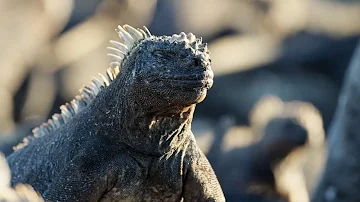
Marine Iguana
Amblyrhynchus cristatus

Meet the Marine Iguana
The marine iguana is a unique species of lizard found exclusively on the Galápagos Islands. It is the only lizard in the world that has adapted to a marine lifestyle, foraging for algae in the ocean. With its flattened tail and strong claws, the marine iguana is an adept swimmer, often seen basking on coastal rocks to regulate its body temperature. Its dark, rough skin helps absorb heat after cold dives, and its blunt snout is specialized for grazing on underwater algae.
Classification
Reptile
Habitat
Rocky coastal shorelines of the Galápagos Islands
Diet
Herbivore
Lifespan
12-20 years
Conservation
Vulnerable
Weight
0.5–1.5 kg
📖Fascinating Facts
Oceanic Lizard
The marine iguana is the only lizard in the world that forages and swims in the ocean.
Specialized Diet
Their diet consists almost exclusively of sea algae, which they scrape from rocks underwater using their blunt snouts.
Thermal Regulation
After swimming in the cold Pacific, marine iguanas must bask in the sun to raise their body temperature back to functional levels.
📋Detailed Description
The marine iguana (Amblyrhynchus cristatus) is a robust, medium-to-large lizard, with adult males reaching lengths of up to 1.3 meters (4.3 ft) and weighing up to 12 kg (26 lbs), though most individuals are smaller. Its body is dorsoventrally flattened, with a laterally compressed tail that acts as a powerful rudder for swimming. The skin is typically dark gray to black, aiding in rapid heat absorption after cold-water foraging, though some subspecies exhibit reddish or greenish hues, especially during breeding season. The blunt, short snout and tricuspid teeth are specialized for scraping algae off rocks underwater. Marine iguanas possess strong, curved claws for gripping slippery substrates and a row of spines along the back and tail. They have salt glands connected to their nostrils, allowing them to excrete excess salt ingested during feeding, often seen as 'sneezing' salt crystals. Socially, marine iguanas are gregarious, forming dense colonies on rocky shores where they bask communally to thermoregulate. Their physiological adaptations allow them to slow their heart rate and restrict blood flow to peripheral tissues during dives, minimizing heat loss and oxygen consumption. These lizards are diurnal, with activity patterns closely tied to tidal cycles and ambient temperature.
💡 Did you know?
Despite being cold-blooded, marine iguanas can spend up to an hour in frigid ocean waters, emerging covered in salt and often shivering to warm up on sun-baked rocks.
🔬Research & Sources
Wikipedia Summary
The marine iguana, also known as the sea iguana, saltwater iguana, or Galápagos marine iguana, is a species of iguana found only on the Galápagos Islands (Ecuador). Unique among modern lizards, it is a marine reptile that has the ability to forage in the sea for algae, which make up almost all of its diet. Marine iguanas are the only extant lizard that spends time in a marine environment. Large males are able to dive to find this food source, while females and smaller males feed during low tide in the intertidal zone. They mainly live in colonies on rocky shores where they bask after visiting the relatively cold water or intertidal zone, but can also be seen in marshes, mangrove swamps and beaches. Large males defend territories for a short period, but smaller males have other breeding strategies. After mating, the female digs a nest hole in the soil where she lays her eggs, leaving them to hatch on their own a few months later.
Last Modified: 5/23/2025
🎭Behavior & Social Structure
Marine iguanas are primarily herbivorous, feeding almost exclusively on marine algae, especially red and green algae species such as Ulva and Gelidium. Large males dive up to 20 meters (65 ft) and remain submerged for up to 30-40 minutes, though most dives last 5-10 minutes. Females and juveniles typically feed in the intertidal zone during low tide, avoiding deeper water to reduce predation risk. After foraging, iguanas return to land to bask, raising their body temperature by as much as 10–12°C. Social interactions include communal basking and occasional aggressive displays, particularly among males during the breeding season. Dominant males establish and defend small territories, performing head-bobbing, push-ups, and tail-slapping displays to deter rivals. Outside of breeding, aggression is rare, and iguanas often pile atop one another for warmth. Daily routines are dictated by the need to balance feeding with thermoregulation, as prolonged cold exposure can be fatal.
👶Reproduction & Life Cycle
Breeding occurs annually, typically from December to March, with timing varying by island and subspecies. Males become territorial, defending small areas on the rocky shore for several weeks. Courtship involves head-bobbing and physical displays, followed by copulation. Females lay 1–6 leathery eggs in burrows dug up to 80 cm (31 in) deep in sandy or volcanic soil, often in communal nesting areas. Incubation lasts approximately 89–120 days, depending on temperature. Females guard the nest for a few days post-laying but provide no further parental care. Hatchlings emerge synchronously and are immediately independent, facing high predation rates from introduced mammals and native birds. Sexual maturity is reached at 3–5 years for females and 6–8 years for males.
🛡️Adaptations & Survival
Marine iguanas exhibit a suite of unique adaptations for their amphibious lifestyle. Their laterally compressed tails and strong limbs enable efficient swimming, while sharp claws provide grip on slippery rocks. Specialized salt glands allow for excretion of ingested salt, a necessity for marine herbivores. Their dark coloration facilitates rapid warming after cold dives, and their metabolism can slow dramatically to conserve energy and reduce oxygen needs underwater. Remarkably, during periods of food scarcity (e.g., El Niño events), marine iguanas can reduce their body length by up to 20%, likely through bone resorption, to lower metabolic demands. Their tricuspid teeth are uniquely adapted for scraping algae, and their flattened snout allows access to algae growing on rocks.
🎨Cultural Significance
Marine iguanas are emblematic of the Galápagos Islands and have become symbols of evolutionary adaptation and natural history. Charles Darwin famously described them as 'hideous-looking' but was fascinated by their unique ecology, contributing to his theories of evolution. They feature prominently in local ecotourism and conservation campaigns, but there is little evidence of traditional use or mythology among indigenous peoples, as the Galápagos were uninhabited prior to European discovery.
🔬Recent Research & Discoveries
Recent research has focused on the physiological mechanisms underlying the iguana’s tolerance to cold and salt, as well as their remarkable ability to shrink during food shortages. Genetic studies have revealed significant divergence among island populations, with up to 11 recognized subspecies, reflecting adaptation to local conditions. Ongoing research tracks the impacts of climate change and El Niño events on population dynamics and reproductive success. Conservation genetics and telemetry studies are informing management strategies, including invasive species control and habitat protection.
🎥Wildlife Videos

Vanishing Dragons - The Sad Fate of the Galapagos' Iguanas | Free Documentary Nature
Vanishing Dragons - The Sad Fate of the Galapagos' Iguanas | Wildlife Documentary Watch 'Wild Galapagos - Part 1: In the Grip ...
Free Documentary - Nature

Wildlife Instincts: Survival Techniques - Iguana vs. Basilisk | Free Documentary Nature
Wildlife Instincts - Episode 2: Survival Techniques - Iguana vs Basilisk | Free Documentary Nature Watch "Wildlife Instincts: The ...
Free Documentary - Nature

The Marine Iguana | A Perfect Planet | BBC Earth
#APerfectPlanet Watch more: Planet Earth http://bit.ly/PlanetEarthPlaylist Blue Planet http://bit.ly/BluePlanetPlaylist Planet Earth II ...
BBC Earth

Rare Look at How Marine Iguanas Feed Underwater | 4K UHD | BBC Earth
Being the only lizard that gets its food from the sea, this reptile can stay underwater for thirty minutes but must come back up for air ...
BBC Earth

David Attenborough's Galapagos - ( Episode 2 )
David Attenborough stumbles upon species found nowhere else in the world that show how life has to quickly adapt to the islands' ...
ScienceNatureJKB

Marine Iguana vs Snake Hunter - Journey of Survival #naturedocumentary | Wild Kingdoom
The evolutionary kingdom of Galápagos is a unique place full of Galápagos wildlife. Here, the animals of Galápagos have evolved ...
Wild Kingdoom
🌍Habitat Information
The Marine Iguana typically inhabits Rocky coastal shorelines of the Galápagos Islands environments. Marine Iguanas have adapted to their environments with specialized features and behaviors.
Primary Habitat:
Rocky coastal shorelines of the Galápagos Islands
More detailed habitat information will be available soon.
🛡️Conservation Status
The Marine Iguana is currently classified as Vulnerable. Conservation efforts are crucial for preserving this species for future generations.
Common Threats:
- 🏠Habitat loss and fragmentation
- 🌡️Climate change impacts
- 🎯Hunting and poaching
- 🏭Human-wildlife conflict
⚠️Threats & Conservation Challenges
Marine iguanas face numerous threats, both natural and anthropogenic. Natural predators include Galápagos hawks, herons, and introduced species such as feral cats, dogs, and rats, which prey heavily on eggs and juveniles. Human impacts include habitat disturbance, pollution, and the introduction of invasive species. Marine iguanas are highly sensitive to environmental changes; El Niño events can devastate populations by reducing algal availability, leading to starvation and mass mortality. Oil spills and plastic pollution pose additional risks. Climate change threatens to alter sea temperatures and disrupt algal growth, further imperiling the species. Population trends are variable, with some colonies stable and others declining, leading to their IUCN listing as Vulnerable.
🔬Scientific Classification
Scientific Name
Amblyrhynchus cristatus
Classification Hierarchy
🔍 About Taxonomic Classification
Taxonomic classification is a hierarchical system used by scientists to classify and organize living organisms based on shared characteristics and evolutionary relationships.
The system moves from broad categories (Kingdom) to increasingly specific ones, with each animal's scientific name typically consisting of its Genus and species.
📝Community Notes
Share your observations and insights about the Marine Iguana with our community of wildlife enthusiasts.
Join Our Community
Sign in to share your observations and connect with fellow wildlife enthusiasts.
Sign In to ContributeNo community notes yet
Be the first to share your observations about the Marine Iguana!
Explore Marine Iguana
Select a tab above to learn more about this amazing animal.
📸Photo Gallery
No photos available for this animal yet.
🌟Discover More Wildlife
Continue your journey of discovery with more fascinating animals from our database
